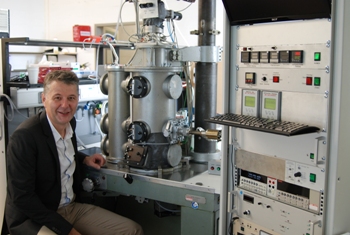Jul 10 2013
Using a special electron beam apparatus, scientists at Bielefeld University can determine the precise three-dimensional structure of gaseous molecules. To do this, Professor Dr Norbert Mitzel’s research team analyses the molecules in their gaseous state. Bielefeld University is the only institution in the European Union suitably equipped to conduct such gas-phase analyses. External research facilities are now able to use the device to have their substances analysed.
 Professor Dr Norbert Mitzel with the improved gas electron diffractometer.
Professor Dr Norbert Mitzel with the improved gas electron diffractometer.
The German Research Foundation (DFG) is providing 550,000 euros over a period of three years to fund the new Core Facility, which has been opened on 3 July, in the presence of international guests.
The Faculty of Chemistry’s instrument is called a gas electron diffractometer. “On a global scale, there are only five other sites with such instruments - Japan, New Zealand, the USA and two in Russia,” says Professor Mitzel, head of the Inorganic and Structural Chemistry research team. Extraordinarily, the Bielefeld instrument is more than four decades old, but it has re-cently undergone substantial modernisation: old casing, new core. Despite its age, it is in great demand because it can measure the structure of substances in the gaseous, free state. The instrument is used predominantly to examine comparatively small molecules. In addition, the Bielefeld research team has the expertise to grow crystals from liquids or gases at low temperatures. In this way X-ray diffraction with two further brand-new instruments also en-ables the measurement of the structure of small molecules in the crystal.
Why is a measuring device needed for gaseous compounds, though? “As scientists, we are interested in how atoms are linked to one another,” says Mitzel. “To determine the precise structure of a molecule, it is best examined in the gaseous state – when it is in its undistorted form, because the molecules do not interact with others. This is different in the solid state because in crystals the molecules are packed and interact with one another more or less strongly.”
With their measurements, Professor Mitzel and his team sometimes find answers to decades-old research questions. External researchers have already benefitted from Bielefeld’s electron diffractometer in a number of cases, when conducting research together with Mitzel’s team. In 2011, for the first time Mitzel’s research group was able to demonstrate precisely at what distances and angles phosphorus atoms are arranged in elementary phosphorus. During the same year, the researchers determined the arrangement of phosphorus atoms in a totally new simple link with arsenic, the AsP3 molecule developed by Professor Christopher Cummins PhD of Massachusetts Institute of Technology (MIT) in Boston. For three years now, the Bielefeld scientists have been conducting joint research with the team of Professor Dr Carlos Della Védova of the Universidad Nacional de La Plata in Argentina. Their research includes models for the transmission of nitrogen oxide, which acts as a neurotransmitter in the body. “It re-lates, so to speak, to the basic mode of action of Viagra,” says Mitzel. But the diffractometer is also used for compounds of industrial interest or such with unusually high energy content, which are sometimes explosive.
To conduct an analysis, an evaporated sample is sucked into the instrument by vacuum, where an electron beam hits the gas stream. From the image created by the diffracted electrons, scientists can calculate how the atoms are arranged in the molecule, i.e. their distances to one another. “The instrument is extremely precise,” says Mitzel. The distances between the atoms are given in Ångström. An Ångström is 0.0000000001 metres. “We can specify the length up to three, sometimes four decimal places of an Ångström,” explains the scientist.
Two years ago, the DFG started a line of funding to enable as many scientists as possible to use special analytical instruments like that of Professor Mitzel’s team. The DFG’s idea is that research facilities up and down Germany place their highly specialised equipment at the dis-posal of external partners. To this end, they are founding centres called “core facilities”, where experts operate the machines for external clients: they prepare samples, measure them and analyse the data. The DFG is funding staff for three years. In future, the core facilities are planned to receive payment for some of the work commissioned – which is at present still unusual in the academic system. The idea is that when the DFG funding comes to an end the facilities should be self-financing. Bielefeld University’s new core facility is called “GED@BI” (Gas Electron Diffraction and Small Molecule Structures Centre Bielefeld).
For further information in the Internet, go to:
www.uni-bielefeld.de/chemie/arbeitsbereiche/ac3-mitzel